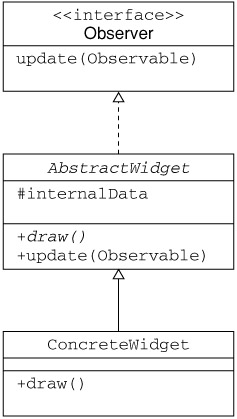The Observer Pattern
The Observer Pattern
Often, you'll have data in your application that changes over time. Say that you have some GUI components that are required to show this data and update it when it changes. How would you handle it? One solution might be to pass the newly updated data to a method of the GUI component so that it could redraw the information. A problem with this approach is remembering to do that each time the data is updated. What if it's not clear how often the data will be updated, and whether you want the GUI to update automatically when it does?
The observer pattern solves this problem by using two interfaces, Observer and Observable. As the name suggests, the Observer "watches'' the Observable to see whether it changes.
| Note | Keeping with the theme of human senses, an Observer is sometimes called a Listener, but for this chapter we stick with the former name. |
In its most basic implementation, the Observable can add Observers. Observable then is responsible for notifying them if anything about its state has changed, and the Observer is responsible for reacting to the change. In this example, our data is the Observable and the GUI components are the Observers. If the data changes, those changes will automatically be reflected in any GUI component that is an Observer of the data. Figure 4-6 demonstrates the observer pattern.

Figure 4-6
Widgets
Continuing with the previous example, you'll use the observer pattern to handle displaying price information for some of the instruments within graphical elements on a Web page. First, you'll need to define some simple graphical components. These components will be basic HTML table structures whose functionality will be contained within an object. Such components often go under the all-purpose term of widgets.
The widgets need to display the same instrument information. For this example, that information is just the instrument's and price.
Designing the Widgets
A graphical widget will have two responsibilities. It will need to draw its own HTML so that it can be seen on a Web page, and it will need to update the data it displays. You may have noticed (from Figure 4-6) that an update method is defined in the Observer interface.
Each widget is an Observer. The item being observed is the data representing the instrument name and price information. The data source is Observable.
All widgets, then, should implement the Observer interface. In addition, each one should descend from an abstract class that defines some shared functionality between widget objects. This is an example of using interfaces and abstract classes together. Because the update() method is the same for all widgets, it can be implemented in the abstract class. The class diagram is shown in Figure 4-7.

Figure 4-7
Now all concrete implementations of widgets will descend from the AbstractWidget class. The AbstractWidget class in turn implements the Observer interface. Notice the update() method in the class diagram for AbstractWidget is not shown in italics. This means that the method is actually implemented at that point. The # symbol indicates that the internalData property is protected. That means subclasses of AbstractWidget have access to it. If it were private, subclasses would not be able to access it.
Take a look at the following Widget code, in a file called abstract_widget.php:
<?php interface Observer { public function update(); } abstract class Widget implements Observer { protected $internalData = array(); abstract public function draw(); public function update(Observable $subject) { $this->internalData = $subject->getData(); } } class BasicWidget extends Widget { function __construct() { } public function draw() { $html = "<table border=1 width=130>"; $html .= "<tr><td colspan=3 bgcolor=#cccccc> <b>Instrument Info<b></td></tr>"; $numRecords = count($this->internalData[0]); for($i = 0; $i < $numRecords; $i++) { $instms = $this->internalData[0]; $prices = $this->internalData[1]; $years = $this->internalData[2]; $html .= "<tr><td>$instms[$i]</td><td> $prices[$i]</td> <td>$years[$i]</td></tr>"; } $html .= "</table><br>"; echo $html; } } class FancyWidget extends Widget { function __construct() { } public function draw() { $html = "<table border=0 cellpadding=5 width=270 bgcolor=#6699BB> <tr><td colspan=3 bgcolor=#cccccc> <b><span class=blue>Our Latest Prices<span><b> </td></tr> <tr><td><b>instrument</b></td> <td><b>price</b></td><td><b>date issued</b> </td></tr>"; $numRecords = count($this->internalData[0]); for($i = 0; $i < $numRecords; $i++) { $instms = $this->internalData[0]; $prices = $this->internalData[1]; $years = $this->internalData[2]; $html .= "<tr><td>$instms[$i]</td><td> $prices[$i]</td><td>$years[$i] </td></tr>"; } $html .= "</table><br>"; echo $html; } } ?>
There are two concrete Widget implementations, FancyWidget and BasicWidget. Both implement the draw() method required from the abstract parent class they extend, yet the implementations are different. Both also inherit the update() method from the parent class.
You might be wondering about the benefit of using the Observer interface when you could just put the single method in the subclasses anyway. Earlier PHP versions provided no direct way to ensure that a method parameter was of a certain type. A new feature in PHP5 called class type hints serves as a way of guaranteeing that the correct type of object is passed as an argument. In the following function declaration, the reference passed as an argument must be of type Observer or you get an error.
public function addObserver(Observer $observer) { If a particular method takes an Observer as an argument as is the case with the Observable addObserver() method you know it's safe to pass a Widget to it. That's because all Widget objects are of type Observer. All widgets descend from the AbstractWidget, which implements Observer, thus the widgets themselves are also that type.
Another question arises: Why not just require the method addObserver() to take a Widget? That way, you could also do away with the Observer interface. Suppose, however, that you wanted to create another type of Observer that wasn't a Widget. Then the class type hint would prevent you from passing any other type of object to the addObserver() method.
